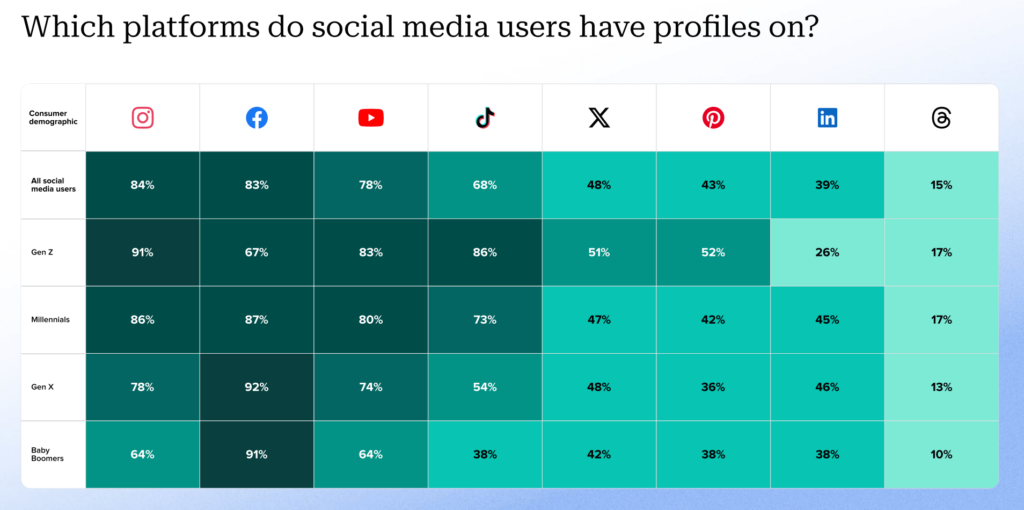The social media landscape is increasingly fragmented, a result of both regulatory changes and evolving algorithms. This is fueling a race among brands to establish equity and relevance in emerging digital spaces, a prospect that understandably worries social marketers. For most of them, their biggest fear is their audiences migrating to private, closed, or niche platforms.
These fears are well-founded, as nearly 40% of marketers report that their audience has already begun to shift more of their time towards emerging platforms like Threads, Bluesky, Lemon8, and Mastodon, per the Q1 2025 Sprout Social Pulse Survey. And 51% of consumers plan to spend more time on community-driven platforms like Reddit over the next six months, according to our Q2 2025 Pulse survey.
This shift has been a long time coming, so why are so many brands still struggling to adapt? Having worked in digital and social media for 20 years, I’ve seen so much change in this space — except for one hard truth. Social marketers aren’t getting the support they need to take big swings on new platforms.
Investing in emerging platforms
Staying relevant in this industry requires brands to have a constant pulse on where their audience is most engaged and where they may be heading next.
Brands focusing solely on established or legacy platforms risk being left behind as new networks emerge. Being an early adopter of emerging platforms offers a significant advantage, allowing your brand to stand out among competitors and industry peers.
I'm not saying you should divest from established social media platforms, but diversifying your strategies will allow you to connect with your audience in a variety of spaces.

Our 2024 Social Media Content Strategy Report found that, when consumers were asked where they wanted brands to stop showing up, their answer was somewhat surprising: nowhere. Every social media network presents unique opportunities for brands to find and grow their community. This is because social media users use different platforms to fulfill different connection and content consumption needs.
But knowing you can’t simply move your brand to every new space, success lies in understanding that today’s consumers value authentic, connection-driven engagement over just having a presence. Even dipping your toes into one or two experimental platforms would be enough to diversify your investments and cover your bases. But here's the kicker: You'll need to make a strong case to your leadership team that it's worth the effort.
How to advocate for platform experimentation
Let’s be honest: So many social teams still struggle to build trust with their leadership and make the case for simpler content approval processes or more production resources. Successfully advocating for investing in a new network starts with capturing the right data and defining a concrete plan.
Use audience data to inform where you want to test
The most sophisticated teams already tap social data to stay attuned to cultural trends and make smarter decisions about what content they create. Those insights can be potent signals to help determine where your brand needs to start showing up.
For example, are you or your competitors seeing audience size declines on legacy networks? Are people starting to talk about your brand or industry in places where you don’t have a formal presence today? Or are creators relevant to your industry successfully migrating to new spaces?
Gather any available insights to show (not just tell) where and why you want to experiment. And remember: Nothing spurs leaders on like knowing they’re being outpaced by other brands. Don’t hesitate to surface examples of other companies that have already diversified their approach.
Set concrete goals to keep your efforts in scope
Exploring new platforms will likely require reevaluating where your team's time is spent. And that's okay! The key is to be upfront about the bandwidth you'll need to reallocate — perhaps 20% — and how that might adjust your usual content output.
Your strongest argument for this move will be a clear, contained experiment with concrete goals. For instance, you could propose, "Over the next three months, we'll use this new platform to grow our community by X%." Remember, metrics like audience engagement and growth tend to grab the attention of marketing leaders.
Should you face pushback, encourage leaders to reflect on how much more growth your brand can truly achieve on networks where you're already well-established. While new platforms don't guarantee instant audience expansion, they do open doors to untapped potential. You might also propose leaning more on user-generated content and influencer partnerships on your current channels to address any dips in performance proactively.
Brands staking a claim on emerging networks
The good news for risk-averse brands is this: There are businesses setting a platform experimentation precedent (and thriving).
For over a year, luxury fashion house Louis Vuitton has maintained an active Discord server. They invite more than 10,000 community members to participate in various conversation threads — from virtual reality, technology, and arts and culture — while sharing exclusive brand content and, most recently, an immersive gaming experience.
Louis Vuitton’s success is an example of a wider trend we’ve observed: Brand accounts are popping up on community-driven networks. From Sephora hosting Reddit AMAs with their beauty directors to Tory Burch’s new Substack, brands are creating spaces for authentic community and forging stronger parasocial relationships with their audiences.

Given how unpredictable social networks can be, doubling down on community management just makes sense. Platforms come and go, but a vibrant, engaged community is something that lasts (and can even thrive!) no matter how much the social media landscape changes.
If you're not sure which new platforms to explore, a good starting point is to look for places where people are already talking about your brand. For example, here at Sprout, we've found success by actively building our community on Reddit, which is home to the second-largest audience of B2B decision-makers, with three out of four saying they plan to use it to inform future purchases.
Success on Reddit lies in understanding its distinct, member-centric approach. Instead of blatant self-promotion, marketers must provide genuine value and become active and contributing members within relevant subreddits to foster meaningful conversations. The platform offers great insight for brands to better understand their consumers and inform proactive strategies.
For Sprout, Reddit users talk about their MarTech stacks and offer unfiltered feedback about our product. Not showing up was an opportunity cost we couldn’t afford.
Embrace change, build resilience
We understand: It can feel overwhelming to carve out time to experiment with new platforms, and there's risk in stepping away from your main networks. However, doing nothing is a greater one.
The social media landscape is constantly evolving, and brands should view times of change as opportunities to build more resilient ecosystems focused on long-term growth. Social marketers already have many skills needed to succeed in these new spaces. Leaders need to give them the support and flexibility to cook.
No one can say for sure which social media platforms will stick around, but one thing's for certain: putting effort into building strong, engaged communities will always pay off.
Follow Layla Revis for insights on brand storytelling and her award-winning work leading social strategy for Fortune 500 companies.
Edited by Jigmee Bhutia
 by Soundarya Jayaraman
by Soundarya Jayaraman
 by Sidharth Yadav
by Sidharth Yadav
 by Sidharth Yadav
by Sidharth Yadav